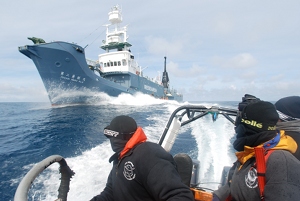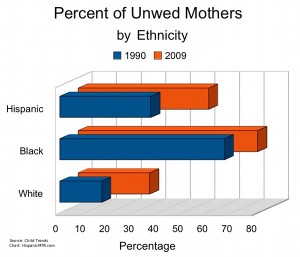Posted by Elena del Valle on March 30, 2012

Confessions of an Ecoterrorist film poster
Video, photos: Peter Jay Brown, Blue Rage Media & Ignition Creative, Kelsey Stevens
Where documentaries often adopt a slow pace side by side with a serious and even somber tone Confessions of an Ecoterrist, a 90-minute docu-homage to the Sea Sheppard, its captain and crew and their exploits, manages to address a topic the film makers are obviously passionate about (30 years of activism attests to that) with a light tone, self deprecating humor and an undertone of incredulity, is fast paced and action packed, for a documentary. Completed in 2011, Confessions of an Eco-Terrorist Nature Needs a Mother Like Him is dedicated to journalist Bob Hunter and contains footage from 1977-2010. SnagFilms, a distributor of independent films on digital platforms, is releasing the feature documentary in the United States for pay-on-demand purchase on Earth Day, April 22, 2012. Click on the play button below to watch a trailer of the film.
The organization’s seaborne positive activism activities over 30 years are summarized and shared in a first hand one sided, account, by Peter Jay Brown, director, activist and longest serving Sea Shepherd crew member. He tells of the exploits, successes and disappointments of Captain Paul Watson and the Sea Shepherd Conservation Society, the stars of Whale Wars, Animal Planet’s Emmy-nominated series. The narrator’s admiration for Watson and the crew is evident.

Baby seal scene from the film
He peppers his narration with humor. For example, early on he explains that the organization relies on the work and support of volunteers aboard including many vegans. “A race of highly dedicated people; healthy, strong and perpetually pissed off,” he says of them. At the same time, he explains volunteers are not on a pleasure cruise and illustrates the hardships they endure such as constant seasickness and limited access to comforts such as showers (once a week). Watson he says is “a brilliant tactician and strategist with uncanny good luck.”
“Many young people today are losing hope. ‘Why bother? Nothing changes!’ they might say. Well I am here to say that change starts with everyone of us and those of us who are determined actually get things done. Get off the couch and get out there and make a positive difference. I did, so can you,” said Brown when asked to comment on the goal of the film.
During the society’s voyages the crew engaged in dramatic conflict including the boarding of ships, arrests (of the captain by the Canadian government, for example), being fired upon by a multimillion dollar vessel of the Norwegian Navy, boarding by an Ecuadorean admiral and successfully ramming and/or sinking illegal whaling and fishing vessels around the globe. According to promotional materials, the group is credited with stopping drift-netting worldwide and saving the lives of millions of marine wildlife.
Most of the film takes place on board or near a Sea Sheppard vessel, in the high seas and coastal areas of the United States, Canada, Antarctica, Faeroe Islands, Norway, Japan, and Galapagos islands of Ecuador. Among other things it includes images of the bloody killing of harp seal and the blood smeared faces of the seal “hunters.”

A scene from the film
The film was released in German speaking countries in December 2011 and is available there in cinemas and on DVD. In the United States, it is scheduled to become available in the VOD (video on demand) sections of cable networks, iTunes, Hulu-Plus, Amazon, and NetFlix in the coming weeks. The price is being determined. DVDs should be available in late April 2012, according to a spokesperson.
Established in 1977, the Sea Shepherd Conservation Society (SSCS) is an international non-profit, marine wildlife conservation organization with a stated mission “to end the destruction of habitat and slaughter of wildlife in the world’s oceans in order to conserve and protect ecosystems and species.” Toward this end Sea Shepherd uses “innovative direct-action tactics to investigate, document, and take action when necessary to expose and confront illegal activities on the high seas.” SnagFilms features free, sponsor-supported, on demand viewing of more than 3,000 award-winning, fiction and non-fiction titles. SnagFilms’ curated collection is available on its own site and a digital network of more than 110,000 affiliated sites and webpages.
Posted by Elena del Valle on March 28, 2012

Andrés Oppenheimer in Oppenheimer Presenta on CNN en Español
Photo: CNN en Español
Starting on the first Sunday in April CNN en Español will air Oppenheimer Presenta, a weekly show hosted by Andrés Oppenheimer, in the network’s United States and Latin America feeds. Every Sunday at 9 p.m. Oppenheimer Presenta will examine “the major trends on current topics and how they affect people, families, and countries.”
The host will present a weekly topic and feature interviews with personalities including analysis and comments by special guests. In the first show, Oppenheimer addresses the legalization of drugs and Colombian President Juan Manuel Santos is the featured guest. The programs will also reflect the topics addressed by Oppenheimer in his weekly The Miami Herald column syndicated to 60 newspapers.
Oppenheimer was a 1987 Pulitzer Prize co-winner, along with the journalism team of The Miami Herald. In 1993, he received the Premio Ortega y Gasset of the newspaper El País in Madrid, and was selected one of the 500 most important journalists of the United States by the Forbes Media Guide. In 2001, he received the Premio Rey de España given by the EFE agency and the King of Spain. The following year, Poder magazine selected him as one of the 100 most powerful figures in Latin America.
CNN en Español, the first 24-hour television network of CNN independently produced in a language other than English, was launched March 17, 1997. The network provides continuous regional and world news coverage with context and in-depth analysis, and shows on the economy, finances, health, technology and entertainment. CNN en Español has a subscriber base up to 27 million households and hotel rooms in Latin America and 7 million households in the United States.
Comments:
Filed Under: Media
Posted by Elena del Valle on March 26, 2012

As any South Florida communicator knows, we work in a diverse market. But whether or not you are bilingual, you can still connect with multicultural customers. Join Juan Carlos Fanjul from CBS 12 as he moderates a discussion on multicultural communication. Panelists will share advice, resources – and maybe even cautionary tales – to help us expand our message to a more diverse audience. Come prepared with questions, and say “hola” to new opportunities to connect.
Panelists:
Gretta Vitta – Ms. Vitta is the host of “ Spanglish con Gretta Vitta”, on “Hola Vision TV” an affiliate station with CBS 12 as well as a radio host for WPBR 1340am. Her articles and columns can be found in many prestigious magazines including “Hispanic in America Magazine,” “Latin Connection Magazine,” and “Sunset Drive Magazine,” which features her column “Destination South Florida with Gretta Vitta.”
Elena del Valle –Ms. del Valle is principal of LNA World Communications, a marketing and communications company, as well as the director and editor of Hispanic Marketing & Public Relations. She is the founding president of the Hispanic Marketing & Communication Association and a former member of PRSA. She served as chair of PRSA’s Multicultural Section and as a judge of its Silver Anvil Awards, and was a member of PRSA’s prestigious Counselors Academy and the organization’s National Advocacy Committee.
Andre Varona – Mr. Varona is the Chief Executive Officer of the Hispanic Chamber of Commerce of the Palm Beaches, where he oversees the organization’s mission of developing and growing the area’s Hispanic market. The Hispanic population in Palm Beach County is now 17% of the total population, and Andre will share insights on how businesses can reach out if they haven’t before.
Wednesday, March 28
11:45 AM to 1:00 PM
Tickets
$20.00 Members of PRSA
$25.00 Guest Tickets
The Embassy Suites
1601 Belvedere Road
West Palm Beach, FL 33406
Register at http://prsapalmbeach.org/meetinginfo.php
Comments:
Filed Under: Media
Posted by Elena del Valle on March 26, 2012

Darin Gibby, author of Why Has America Stopped Inventing?
Photo: Planned Television Arts
A podcast interview with Darin Gibby, author, Why Has America Stopped Inventing (see Patent attorney explores reduction of inventions in America), is available in the Podcast Section of Hispanic Marketing & Public Relations, HispanicMPR.com. During the podcast, Darin discusses the declining innovations in the United States with Elena del Valle, host of the HispanicMPR.com podcast.
In addition to his legal practice as a patent attorney with Kilpatrick Townsend, Darin finds time to write about important issues facing America such as the innovation drain caused by the burdensome patent system. He has dedicated nearly two decades to obtaining patents on hundreds of inventions and building IP portfolios for Fortune 500 companies. He also helps clients enforce and license their patents around the world, and he has monetized patents on a range of products from computer disk drives to in-line skates.
A triathlete, he also enjoys back country fly-fishing trips and skiing in the Rocky Mountains. He lives in Denver, Colorado with his wife and four children.
To listen to the interview, scroll down until you see “Podcast” on the right hand side, then select “HMPR Darin Gibby” click on the play button below or download the MP3 file to your iPod or MP3 player to listen on the go, in your car or at home. To download it, click on the arrow of the recording you wish to copy and save it to disk. The podcast will remain listed in the March 2012 section of the podcast archive.
Posted by Elena del Valle on March 23, 2012

Banding Together for A Cause book cover
Photo: Newman Communications, Inc.
Nonprofit organizations are often in need of funding and public relations on a shoestring. Drawing the attention of the public and potential donors to their cause or organization requires time, effort and the right mix of positioning and branding. Ribbon and wrist band campaigns have become a common way to bring people together and catch attention in an easy and affordable way. For many people wearing wrist bands for a cause or as a reminder of something important to the wearer gained great momentum years ago thanks to the Lance Armstrong Foundation.
Lance Armstrong, the world famous cyclist, brought sympathy and attention to cancer and his race by wearing a yellow wristband in one of the best known awareness campaigns of the past decade. The Livestrong campaign, created to raise money for the Lance Armstrong Foundation and cancer research, reached its goal within six months and has raised more that $500 million for the cause.
“If I hadn’t personally been involved in the campaign. I almost wouldn’t believe it,” said Rachel Armbuster, former director of development for the Lance Armstrong Foundation (2000-2006), overseeing all fundraising and managing the Nike relationship that created the Livestrong gel bracelet campaign.
In her recently published book, Banding Together for a Cause: Proven Strategies for Revenue and awareness Generation (Wiley, $45), Armbuster set out to provide insights and pose questions to guide others who wish to embark on their own yellow wristband journey. Through her efforts she hoped to assist others seeking ways to generate funding through partnerships.
The 232-page hardcover book is divided into nine chapters: The Importance of Time in Moving Your Mission Forward, Reflecting the Essence and Spirit of Your Organization Through Banding, The Right Partnerships, Pinpointing Experts and Using Their Strenghs, The Role of Strategic Planning in Your Mission’s Success, Assembling the Perfect Team, Strategies for Integrating and Mobilizing, Creating Feedback Mechanisms, and What It Takes to Be a Visionary.
The author believes better branding can be accomplished by following the process, focusing on improvement and having passion for the relationships that pave the way for success. It is important to be a leader and to be discriminating in your use of resources, she says in the book.
Armburuster is an executive nonprofit strategist and founder for Armbruster Consulting. According to her bio, she has provided consulting services to hundreds of organizations seeking to improve goals actualization, program management, development and training, department integration, or corporate partnership program development. She lives with her husband and two sons in Austin, Texas and serves on the Fertility Advisory Committee at Livestrong.

Click to buy Banding Together for a Cause
Comments:
Filed Under: Books
Posted by Elena del Valle on March 22, 2012

Title: President
Type: Full Time
Application Deadline: April 15, 2012
The National Hispana Leadership Institute is seeking a new dynamic President who will work to build and strengthen NHLI’s staff capacity, increase our alumnae network, work as a liaison between our Alumnae Association and the Board of Directors, as well as support a focused mission that promotes Hispanas as ethical leaders in local and national communities. The President will be responsible for overseeing Operational Management, Resource Development, Programmatic Oversight, as well as Marketing and Communications Initiatives.
For more information about the position, and to apply please visit: http://www.nhli.org/jobs.htm
Posted by Elena del Valle on March 21, 2012

The Social Media Monthly magazine March 2012
Photos: The Social Media Monthly
While media in general have been shrinking nationwide (see Report outlines media evolution, growth of new and online media), and many have been shedding veteran employees there are a handful of new publications. For example, last year Cool Blue Company, LLC in Washington, D.C. launched The Social Media Monthly magazine targeting general consumers and the 99.9 percent of the population “that don’t consider themselves social media experts.”
The print magazine has 64 pages in addition to the cover and a fifty fifty split between editorial and advertising content. A single full-time staff person, editor-in-chief Bob Fine, produces the monthly magazine with a retail circulation of 23,000 in 19 countries. An annual subscription costs $34.99 and a single issue, available for purchase on the magazine website, costs $6.99.

The Social Media Monthly magazine January 2012
As of this writing the online edition lists individual articles by Rory Cooper, Adriel Hampton, Silvia Baroni, Faye Anderson, Mike Brown, Rose De Fremery, Ted Nguyen, Masha Hedayati, Amy Vernon, Dave Sachse, and Sterling Zumbrunn. Topics in that issues, according to the website, include data collection, political Tweets, moms blogging and brands, the United Nations, mobile apps, the Republicans and social media, Obama 2012, and little known social networks.
Comments:
Filed Under: Media
Posted by Elena del Valle on March 19, 2012

Unwed Mothers in the United States – click to enlarge
When it comes to marriage there are clear distinctions between ethnic and racial groups. It seems white and Hispanic women are more likely to ever marry than are black women. At the same time, Hispanic women who marry tend to do so at a younger age than do women of other ethnicities, according to information provided by a research scientist at Child Trends, a Washington, D.C.-based nonprofit, nonpartisan research center that studies children at all stages of development.
Researchers estimate that more than half of all births outside of marriage are to cohabiting couples. Sixty-five percent of nonmarital births to Hispanic, 61 percent to white and 30 percent to black women are to cohabiting couples. Hispanics living together with children tend to be more stable unions over time than couples of other ethnic backgrounds.
When it comes to having their first child there are also differences. For example, the average age at first birth for white women is 26 years compared to 22.7 years for black women and 23.1 years for Hispanic women. Hispanic women have, on average, more children than do white or black women.
Over the years more women having been having children without being married. In 1990, 17 percent of all births to white women, 67 percent of all births to black women, and 37 percent of all births to Hispanic women were outside of marriage. By 2009, 29 percent of all births to white women, 73 percent of births to black women, and 53 percent of births to Hispanic women were outside of marriage, according to the Child Trends data.
Posted by Elena del Valle on March 16, 2012

The Blame Game book cover
Photos: Free Press Publicity, Seth Dinnerman
Studies at the Center for Creative Leadership indicate one of the reasons managers fail is because they lack good people management skills. Although it’s good to know someone has studied the issue for many employees and some managers this may be well known information. Ben Dattner, Ph.D., a New York City organizational psychologist and workplace consultant, is convinced that there is high pressure in organizations to assign credit or blame and that this process causes conflict and managerial problems. The best way to win that game is to refuse to play, according to Dattner.
In The Blame Game: How the Hidden Rules of Credit and Blame Determine Our Success and Failure (Free Press, $16), published in hardcover in 2011, Dattner examines the issue. Last month, the book was published first the first time in a 245-page paperback edition.

Ben Dattner, Ph.D., author, The Blame Game
The author identifies 11 types of people he believes are the most common players of the blame and credit game: Bold, Cautious, Colorful, Diligent, Dutiful, Excitable, Imaginative, Leisurely, Mischievous, Reserved and Skeptical.
When credit and blame are well managed people are willing to experiment, learn and grow; when they are poorly managed people shut down, become demotivated and concerned with protecting themselves, according to the author. In the book, he examines the credit and blame style of management and proposes ways in which individuals and organizations can make credit and blame play a positive role to drive growth and change instead of a negative force that drives stagnation and failure.

Click to buy The Blame Game
Comments:
Filed Under: Books
Posted by Elena del Valle on March 14, 2012
By Roshini Rajkumar
Speaker, Roshini Performance Group

Roshini Rajkumar, speaker, Roshini Performance Group
Photo: Roshini Performance Group
Leave Things As You Found Them
If the overhead compartment was closed before you used it, re-secure it after you’re done stowing your carry-on items. This also applies when you attend business functions or meetings. Do you find some people don’t even clean up after themselves when they eat or take a coffee break? Leave shared business spaces as you found them; bonus points for leaving those spaces in better shape than how you found them.
Click to read the entire Business Etiquette on Land and in the Air


























